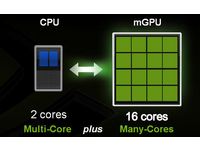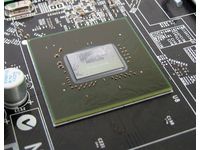Move Over G45: Nvidia's GeForce 9300 Arrives
Introduction
Intel wears the desktop processing performance crown. Yet AMD maintains a faithful following of value-oriented customers who see suitable speed from the company’s quad-core Phenoms at a price point way below Intel’s Extreme Edition CPUs. Even more compelling to AMD’s admirers is the company’s chipset lineup, which was bolstered by the acquisition of ATI.
At the high-end, you have 790FX—now being paired to the SB750 southbridge on a number of compelling motherboards (check back for a roundup of the available 790FX/SB750 combinations later this month). The mid-range is being covered by 790GX, with its integrated graphics and SB750-driven Advanced Clock Calibration overclocking aid. And cleaning up at the sub-$100 motherboard price point is 780G, a capable chipset with “powerful-enough” Radeon HD 3200 graphics able to handle any low-impact desktop environment you can throw at it. The platform isn’t really suited to first-person shooters, but it is a DirectX 10 part able to handle extremely low-resolution gaming at playable frame rates.

But this story isn’t about AMD’s favorable position in the eyes of those buying motherboards with onboard graphics, though we will revisit the power and performance characteristics of its 790GX chipset a little later. Rather, we’re looking at a brand new platform from Nvidia called GeForce 9300, which Intel may grow to simultaneously love and hate. They’ll love it because Nvidia’s latest mGPU bites at the throat of AMD’s mainstream attractiveness. They’ll hate the GeForce 9300 because it’s indiscriminate in its attack, meaning it also snaps at Intel’s own recently-polished G45. And given Nvidia’s experience in integrated graphics, this platform is really something for Intel to eye warily.
Integrated Chipsets: Always Advancing, Never Catching Up
With predictable regularity, AMD and Nvidia refresh their chipset lineups using technology derived from once-modern discrete architectures. Each time, the list of advancements seems like it could bring desktop gaming into the realm of possibility for budget-minded buyers. But motherboard-down graphics just never seem to catch up enough for much else besides basic productivity and a little entry-level entertainment. Intel’s offerings fare far worse, victims of underpowered graphics hardware and unfortunately tardy driver development—which brings us to where we are today.

Despite its Computex unveiling in June of 2008, G45 is still suffering from the teething pains of what we’d consider to be a brand new piece of hardware. Problems with hardware-accelerated Blu-ray playback, disappointing 3D performance, and dismal game compatibility have plagued testing with the latest drivers. Crysis, Unreal Tournament, and World in Conflict all demonstrated severe rendering issues that’d make each of those games unplayable, even if frame rates were acceptable. Moving on.
AMD fares much better—expected, since the graphics engine driving its 780G and 790GX chipsets is more than a year old and is consequently quite mature. Like Intel’s G45, AMD’s integrated chipsets are able to offload Blu-ray playback, though you’ll see later in this review that the technology is still evolving and far from perfect. Nvidia’s GeForce 9300 needs to usurp AMD’s incumbent platform story in order to win favor. G45 isn’t nearly as threatening, it’d seem.
Get Tom's Hardware's best news and in-depth reviews, straight to your inbox.
Current page: Introduction
Next Page Out Of The Chipset Business? Not Yet, At Least-
Ryun Good article but I feel compelled to say that I don't understand your choice for pitting the 790GX (~$140 board) and a 5400+ (~$80) with an the E7200 (~$120) and the G45 (~$100).Reply
Wouldn't it have made more sense to pair up similarly priced components, such as the 780g and 5400+ vs a E2180 and G45? Maybe someone could explain the reasoning? -
ricstorms I think a better Intel processor for an apt comparison should have been the E5200, which is only about $10 more expensive than the 5400+. Also, no mention was made that the 790GX platform is much more versatile, thanks to its 2 PCIExpress x16 slots (albeit running in x8 mode in Crossfire). Also, I would have liked to see the overclocking results with all three platforms, that is one of the strengths of the 790GX platform. (since AMD processors have fallen from grace, its almost impossible to find good reviews, I didn't see one in a google search for the 5400+ black edition)Reply
I think that the 780g platform is more analogous to the 9300. I would have liked to seen either a 8650 or a 6000+ competing on that than a 5400 on the 790GX, many of its features are not being used here. That being said I still think the Nvidia/Intel platform would fair better. It seems to me that this article is at some points aimed at gamers and at other home theater enthusiasts. I think the article would have been better suited focusing on either one, not both. -
chaohsiangchen I agree with Ryun about the price comparison.Reply
Cheapest G45 board is around $109 from Intel (discarding ECS) on newegg. G31 is outdated.
$100 730i board would be pitted against G45 board directly.
780G boards are slightly cheaper and still more capable then NVIDIA MCP7x and any Intel IGP solution. JetWay is offering JetWay HA07 790GX/SB750 board for $90 on newegg at the moment.
-
Reynod I still don't understand how you can say the AMD system draws less power at idle then declare the Intel system to be the winner i nthe power stakes??Reply
Can you please explain that one?
I would hardly put a 5400+ in a HTPC either ... I'd throw in a low power dual core ... bet that would make mincemeat out of the Intel systems and still give quality playback and much smoother graphics up on the screen.
Plus we all know the NVidia Graphics chips in this iteration are defective ... why buy a defective mobo to begin with?
It might not last very long.
Doesn't make good purchasing sense.
Even Apple are publicly stating that all current GPU's have defective substrates causing bonding issue, reducing the lifeltime of the GPU largely based on thermals I guess.
The E7200 is a good performer ... very good in fact. -
Liuqyn if they had done that, then they would have had to admit that AMD was still the better value for entry level gaming and HTPC use.Reply -
marees I agree perfrectly with Ryun that you cant compare e7200 with ath 5400.Reply
I would like to add that a phenom (8450?/9550?) processor should have been used because of the higher hyper transport speed advantages and also to check if the power consumtion is different.
Hopefully TomsHarware will update the figures including scores for phenom processor and also nvidia 8200/8300 chipsets for amd processors, just for completeness sake. -
chaohsiangchen ReynodPlus we all know the NVidia Graphics chips in this iteration are defective ... why buy a defective mobo to begin with?It might not last very long.Reply
Not true. Don't believe anything comes out from Charlie Demerjian until proven. -
Shadow703793 Well written! Next time do you mind posting a bit on if the board is capable of OCing a bit?Reply -
cangelini ryunGood article but I feel compelled to say that I don't understand your choice for pitting the 790GX (~$140 board) and a 5400+ (~$80) with an the E7200 (~$120) and the G45 (~$100).Wouldn't it have made more sense to pair up similarly priced components, such as the 780g and 5400+ vs a E2180 and G45? Maybe someone could explain the reasoning?Reply
Ryun,
The Intel- and AMD-based platforms both add up to $220. Assuming all other components are the same (memory, HDD, PSU, etc), you end up with two machines that cost the same amount of money. -
cangelini ricstormsI think a better Intel processor for an apt comparison should have been the E5200, which is only about $10 more expensive than the 5400+. Also, no mention was made that the 790GX platform is much more versatile, thanks to its 2 PCIExpress x16 slots (albeit running in x8 mode in Crossfire). Also, I would have liked to see the overclocking results with all three platforms, that is one of the strengths of the 790GX platform. (since AMD processors have fallen from grace, its almost impossible to find good reviews, I didn't see one in a google search for the 5400+ black edition) I think that the 780g platform is more analogous to the 9300. I would have liked to seen either a 8650 or a 6000+ competing on that than a 5400 on the 790GX, many of its features are not being used here. That being said I still think the Nvidia/Intel platform would fair better. It seems to me that this article is at some points aimed at gamers and at other home theater enthusiasts. I think the article would have been better suited focusing on either one, not both.Reply
Hi Rick!
You're right on the money about the 790GX's support for CrossFire. I'll look for a place in the piece to add mention of that. The 790GX chipset isn't going to add anything to overclocking in this particular comparison, though, since it's not a Phenom in the socket, but an Athlon 64 X2.
I believe this platform is best suited to an HTPC crowd, but I couldn't ignore Nvidia's insistence that gaming is good here as well. And to that end, I'd still recommend an add-in board under $100 like AMD's Radeon HD 4670.
